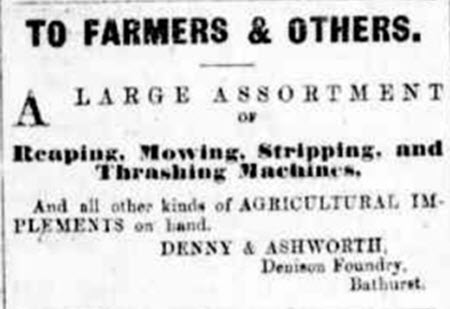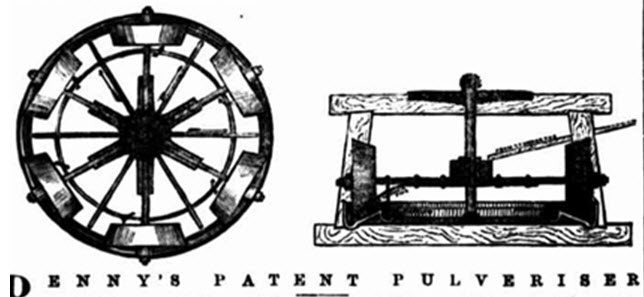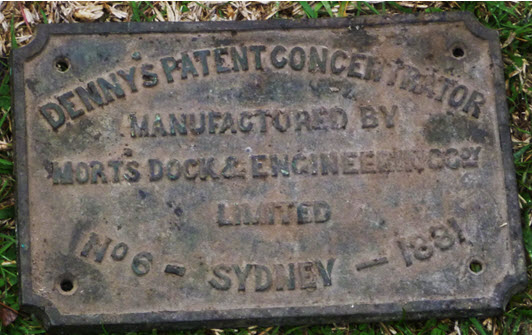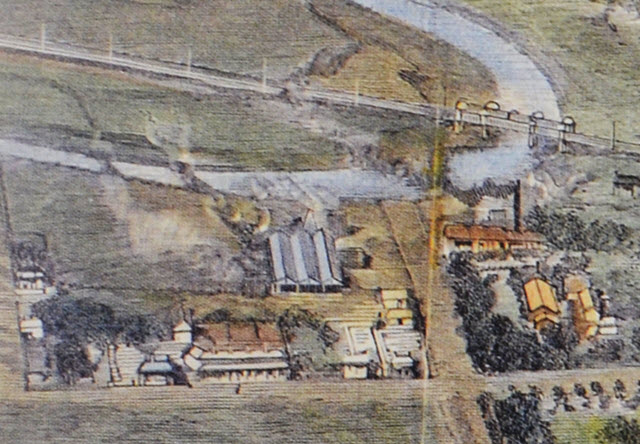“Denny was here 1881”
There was a young man named Denny, who left his mark in the “Flat”.
At Solitary he tried,
with machines he contrived.
To extract gold from sulphide.
He failed, moved on, his offspring thrive.
Technology their hive,
Our humble Flat, a step, in the building of global technologies.
Before pitting his skills on the refractory ore at Solitary Mine, Wattle Flat, Thomas Denny made a much bigger mark in Bathurst. His origins remain a bit of a mystery, but we do know that he was in Deptford, London working at the Thames docks aged 19 in 1854. A few years’ later in 1861, records show he has come to Australia, presumably to try his luck on the goldfields. In Rutherglen, Victoria, he marries Agnes McKibbin, and runs a business as a livery stable keeper. In 1863 his business fails and he is recorded as being insolvent. The next we hear of him is in 1866 when he has become publican of the Denison Bridge Hotel, in Bathurst.
Denny must be meeting with some very inspiring & enterprising people, because in 1867, he & Philip Beckett establish an iron works company that becomes known as the Denison Foundry. Denny’s company employs Mr A Mott for his technical expertise. In the following year, Beckett is replaced by John W Ashworth as Denny’s business partner. Over the decade 1868-1878 the Denison Foundry becomes one of the largest & best equipped in the inland region with up to 80 employees. It contains a sophisticated array of machines all driven by steam power. It is involved in the manufacture if a variety of parts & whole machines for use in the farming, mining, transport & building industries. Denny’s company also focused on the development of improvements to existing tools & machines. In 1869 the building of the new Denison Bridge, Bathurst (which still stands today) relied on iron products produced at the Denison Foundry. This would have assisted the company to grow quickly. The previous Denison Bridge built of wood in 1856 was washed away in the great flood of 1867; the year after Denny 1st arrived in Bathurst.
Alongside the foundry business, Denny has a branch operating a bone crushing machine, for the production of agricultural lime powder. His company is operating a 1090 acre wheat farm named Lansdown in Raglan, and in 1868 he wins the contract to operate a stage coach mail service between Bathurst & Cowra 3 times a week for 3 years.
Despite all this work, Denny finds time to focus on the particular difficulties miners in the goldfields are having in extracting gold from the refractory sulphidic ore found below the water table in the ground. He designs & builds machines to solve this problem, and patents his designs. In 1873/74 he & William Roberts develop & patent an improved pulverizing & buddle machine for the separation of gold from sulphides.
The arrival of the railway in Bathurst in 1876 had a significant negative impact on the business at Denison Foundry. Two years later Denny sells the foundry to Mr R R Blair and he seeks new business opportunities that connect with his mineral technology ideas.
During the 1870’s Thomas & Agnes have 8 children. They live in the Dairy house on Havannah street.

1868 Advert for Denison Foundry products

Drawings of Dennys 1874 machine for separating gold from sulphides

Name plate from Denny’s 1881 concentrator installed at Solitary mine, Wattle Flat

1895 Aerial Map of foundry site & dairy house where the Denny family had lived & worked, Havannah St, Bathurst
In 1881, Thomas Denny acquires gold mining leases at the Solitary Mine, Wattle Flat. The previous owners of this underground reef mine, had struggled with high water inflow in the shafts & drives, and had struggled to extract payable gold from the sulphidic ore. It had been recorded that the exposed ore at the bottom of the mine was rich & carried ore grading 2 oz Au/ton. Denny formed a company named “The Solitary Reef Gold Mining Company NL” to invest & develop the Solitary Reef gold resources. This company dewaters & rehabilitates the shafts, installs an array of industrial machinery & buildings, and constructs a large dam. After considerable financial expenditure (£3000), only limited ore was mined, and the gold extraction did not achieve the expected results. Denny seems to lose interest in the Solitary Mine and tenders it out to local miners. He is involved in several other mines in the district at Cudgegong & Tomingley etc. In the late 1880’s Denny’s Company assets at the Solitary Mine is forcibly sold by public auction. Denny moves to Melbourne, Victoria, where he continues to develop devices that might extract payable gold from sulphidic ore. In the early 1890’s he applies his technological passion with his latest patented gold extraction process to the Tusschenbyde mine in Zululand, South Africa. After investing heavily & establishing a mill, the critical test again gives disappointing results. He dies defeated in Zululand in 1895 aged 60.
After Denny relinquishes the Solitary mine, another technologist from Blayney plies his innovative skills to the intractable sulphidic ores there. This guy was Dr Alfred Florance who experiments with fluxes in the late 1880’s. In 1890 he establishes the Austral Pyrites Company to treat the sulphidic tailings that have accumulated at the Solitary Mine over many years. Test are undertaken yielding mixed results, but this technology is soon to become redundant as the application of new chemical technology using cyanide emerges in 1891. Cyanide technology proves to be the solution to Denny’s quest – the efficient extraction of gold from intractable sulphidic ores. This new cyanide technology suddenly makes countless uneconomic gold mines around the world commercially viable again. It plays a significant part in making Wattle Flat a vibrant community again with its 3rd gold mining boom period between 1890 & 1910.
Denny’s eldest son Thomas James Denny, who was aged in his early 20’s while the Solitary mine was being revamped, and would have been keenly involved in the technological developments & experimentation. After studying, he relocates to London & goes on to develop numerous technological devices of his own and registers patents for them. Some of his innovations developed between 1887 & 1905 include devices for improved extraction of metals from ores, and systems designed to economically extract combustible gases from solid fuels. This is the period when the combustion engine emerges as a predominant technological entity. Another son, Henry Samuel Denny became a noted chemical engineer. He developed important mineral extraction processes including filter pressing and cyanide circulation systems in South Africa. He also designed & commissioned factories for the production of high explosives.
A puzzle in this Denny story is : How does a young guy working in the London docks with no known special education become: (1) a key player in the industrial history of Bathurst; (2) so passionate about the creation of better tools, machines and systems for use in farming, and in mineral extraction. Is it in his DNA, or is it something he learnt? Or was he just the right person, in the right situation to seize an opportunity for significant growth?